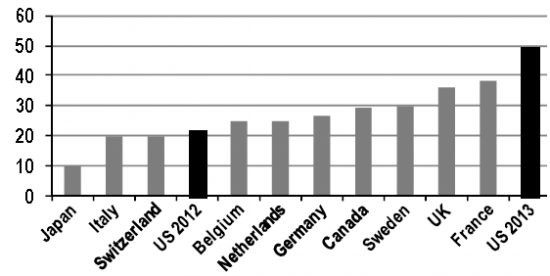08 октября 2012, 13:18
С 1 января 2013 года, максимальная ставка налога на дивиденды в США станет самой высокой
С 1 января 2013 года, максимальная ставка налога на дивиденды в США официально станет самой высокой в развитых странах мира. Если вы живете в Нью-Йорке например, максимальная ставка на дивиденды будет близка к 50%. Что значительно выше, чем во Франции.
По данным JPMorgan, этот налог на дивиденды обойдется крупным фирмам в $ 1,5 трлн. Это приведет к снижению потребительских расходов, чуть более $ 50 млрд.Многие фирмы будут выбирать выкуп акций вместо дивидендов. Не очень хорошо для тех, кто полагается на дивиденды (например, пенсионеры).
Также правительство не получит некоторый доход от налогов на дивиденды.

По данным JPMorgan, этот налог на дивиденды обойдется крупным фирмам в $ 1,5 трлн. Это приведет к снижению потребительских расходов, чуть более $ 50 млрд.Многие фирмы будут выбирать выкуп акций вместо дивидендов. Не очень хорошо для тех, кто полагается на дивиденды (например, пенсионеры).
Также правительство не получит некоторый доход от налогов на дивиденды.

Читайте на SMART-LAB:

Тренды на наступающий год. Низкая инфляция и стагнация
О трендах на наступающий год. Низкая инфляция и стагнация. ЦБ удается приблизить официальную инфляцию к таргету: таргет 4%, а последние ценовые срезы дают около 6%. Что дальше, 4-5% или...
06:59

💼 Снова в школу: сектор «Девелопмент»
Сегодня в 10:00 МСК Академия для эмитентов Московской биржи приглашает на вебинар «Как читать нефинансовую отчетность: сектор „Девелопмент“». Вы узнаете:
📍 О ключевых особенностях отрасли...
24.12.2025












The Bush tax cuts created the concept of «qualified dividend income,» which currently allows dividends received from domestic corporations and certain foreign corporations to be taxed at the taxpayer's long-term capital gain rate. Additionally, qualified dividend income earned by mutual funds and exchange-traded funds may be distributed to shareholders and treated as qualified dividend income by the shareholder. Prior to the Bush tax cuts, all dividend income was taxed as ordinary income. If Congress fails to extend these provisions, the qualified dividend income provisions will expire, and all dividends will once again be taxed as ordinary income. Most notably, taxpayers in the highest marginal income tax bracket who currently enjoy the 15 percent rate on qualified dividend income will be taxed at 39.6 percent for dividends received from the same issuer in 2013. Additionally, the 3.8 percent Medicare contribution tax discussed below will increase the effective rate of tax on dividend income for certain higher-income taxpayers to as high as 43.4 percent. The following table sets forth the scheduled rate increases.